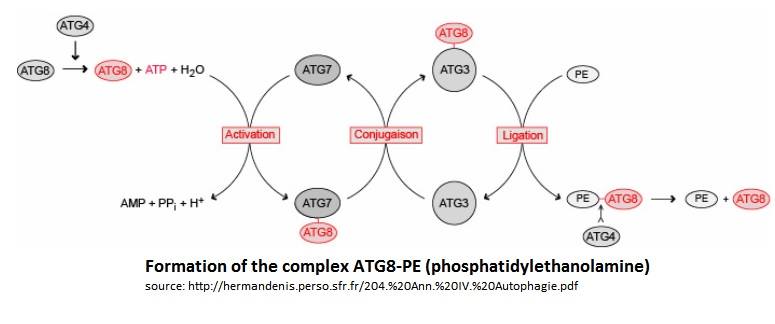Sandbox Reserved 1137
From Proteopedia
(Difference between revisions)
| Line 6: | Line 6: | ||
=== Cellular effects === | === Cellular effects === | ||
---- | ---- | ||
| - | The autophagy related proteins (Atg) are proteins which purpose is to help the parasite to survive and develop. Atg8 and Atg3 are both involved in the [https://en.wikipedia.org/wiki/Autophagy autophagy] process, by creating an autophagosome and then making it grow. The autophagosome can be compared to a vacuole and absorbs the components of the cytoplasm (in a non specific way). When the growing phase (sporozoite) of the cell is over,in the case of ''Plasmodium falciparum'', the autophagy is launched by the cell in order to become erythrocytic-infective. This is the time when the cell starts its viral activity. Lysosomes then merge with the autophagosme to form the | + | The autophagy related proteins (Atg) are proteins which purpose is to help the parasite to survive and develop. Atg8 and Atg3 are both involved in the [https://en.wikipedia.org/wiki/Autophagy autophagy] process, by creating an autophagosome and then making it grow. The autophagosome can be compared to a vacuole and absorbs the components of the cytoplasm (in a non specific way). When the growing phase (sporozoite) of the cell is over,in the case of ''Plasmodium falciparum'', the autophagy is launched by the cell in order to become erythrocytic-infective. This is the time when the cell starts its viral activity. Lysosomes then merge with the autophagosme to form the autolysosome. Once this process is done, the autolysosome can complete its purpose : recycle the its content. Infact, all the molecules inside are degradated and their components (like aminoacids) are reused in order to synthetise viral proteins. |
=== Molecular effects === | === Molecular effects === | ||
---- | ---- | ||
| - | In the Atg8 system, there are several steps until Atg8 is activated. Firstly, the cysteine protease Atg4 cleaves the last residue of the C-terminal domain of Atg8 by consuming 1 molecule of | + | In the Atg8 system, there are several steps until Atg8 is activated. Firstly, the cysteine protease Atg4 cleaves the last residue of the C-terminal domain of Atg8 by consuming 1 molecule of ATP and H20. Then, the Atg7 (E1-like enzyme) activates the C-terminal glycine exposed and therefore forms an intermediate Atg8-Atg7 by creating a thioester bond. Atg3 (E2-like enzyme) then replaces Atg7 in the complex to form an Atg8-Atg3 thioester intermediate. Phosphatidylethanolamine (PE) then links to the N-terminal domain of Atg8. This final complex (Atg8-Atg3-PE) serves as an intermediate for membrane tethering and hemifusion of the autophagosome. This complex is primordial for the elongation of the autophagosome. Notice that Atg8-Atg3-PE is the active complex, but Atg8-PE can also be sufficient to do this task (like this is showed on the scheme below). |
[[Image:atg8f.jpg]] | [[Image:atg8f.jpg]] | ||
| Line 15: | Line 15: | ||
== Disease == | == Disease == | ||
Malaria is an infectious and lethal disease transmitted by [https://fr.wikipedia.org/wiki/Anoph%C3%A8le Anopheles mosquitos], leading to the apparition of fever, vomiting, fatigue or even coma. If this disease is not well treated, the symptoms could return even months after and can infect humans as well as other animals. | Malaria is an infectious and lethal disease transmitted by [https://fr.wikipedia.org/wiki/Anoph%C3%A8le Anopheles mosquitos], leading to the apparition of fever, vomiting, fatigue or even coma. If this disease is not well treated, the symptoms could return even months after and can infect humans as well as other animals. | ||
| - | The | + | The parasite, a plasmodium type (''Plasmodium falciparum'' for humans), introduced by the female mosquito, will infect the hepatic cells then the victim’s blood in order to destroy the red blood corpuscule. |
== Relevance == | == Relevance == | ||
| + | Malaria is a strikening disease killing more than millions of people every years, primarily children. This is one of the most killing disease on earth at this time. That's why it is essential to focus the medical research on malaria's treatment. | ||
| + | Recent studies (2012) have shown a start point for drug researches. In fact 1,2,3-tihydroxybenzene have shown to prevent protein-protein interaction between Atg8 and Atg3, inhibiting autophagosome's elongation and leading to the no-infectiveness of the parasite. | ||
| + | |||
== Structural highlights == | == Structural highlights == | ||
| Line 26: | Line 29: | ||
→ the first region has 80 residues and has a random coil structure in solution, this region is responsible for the Atg7 interaction which is an E1-like enzyme. | → the first region has 80 residues and has a random coil structure in solution, this region is responsible for the Atg7 interaction which is an E1-like enzyme. | ||
→ The second is an alpha-helical structure which protrudes from the core region. This alpha-helical structure is responsible for binding Atg8. | → The second is an alpha-helical structure which protrudes from the core region. This alpha-helical structure is responsible for binding Atg8. | ||
| - | Moreover some researches indicates that the catalytic cysteine of Atg3 is a possible binding site for a phosphate of | + | Moreover some researches indicates that the catalytic cysteine of Atg3 is a possible binding site for a phosphate of phosphatidylethanolamine. |
===Atg8 protein=== | ===Atg8 protein=== | ||
---- | ---- | ||
Revision as of 20:32, 29 January 2016
| This Sandbox is Reserved from 15/12/2015, through 15/06/2016 for use in the course "Structural Biology" taught by Bruno Kieffer at the University of Strasbourg, ESBS. This reservation includes Sandbox Reserved 1120 through Sandbox Reserved 1159. |
To get started:
More help: Help:Editing |
Plasmodium falciparum Atg8 in complex with Plasmodium falciparum Atg3 peptide
| |||||||||||
References
http://hermandenis.perso.sfr.fr/204.%20Ann.%20IV.%20Autophagie.pdf

